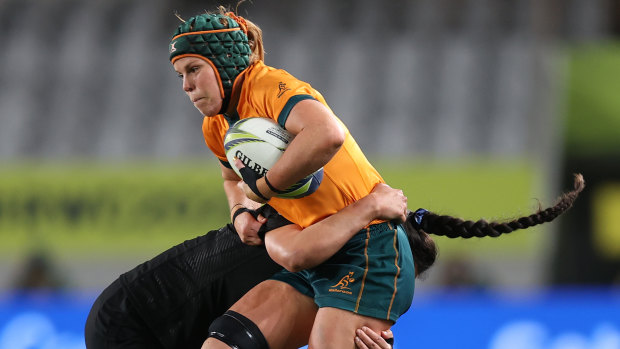This was published 2 years ago
‘Disadvantaged position’: Wallaroos play on despite funding chasm
A senior Australian player has admitted the Wallaroos are “playing from a disadvantaged position” after their 17-point lead was swallowed up by the class of a professional New Zealand outfit at the women’s World Cup.
Emily Chancellor, a constant of the Australian back row since her debut in 2018, said the chasm between the programs of the amateur Australians and their full-time counterparts was no excuse for Australia letting their lead slip at Eden Park in their opening pool game.
But the 31-year-old said there was no escaping the reality of funding differences across the tier one nations.
“If you look at the way we played at the start of the year to the way we played [on Saturday], you can see that in the short time we’ve had together we’ve developed so well as a team,” Chancellor said.
“You look at it and go ‘holy smokes, if we had more resources and looked at that full-time option, like the other teams we’re competing against’, of course we’d be more competitive against New Zealand’. We had 30 minutes against a professional team where we’re completely dominating the game and then their professionalism comes into play and they come over the top of us. We’re playing from a disadvantaged position.
“We’re not going to use it as something to stand behind or as an excuse but it’s the reality of women’s rugby here and the differences around the world in terms of the investment (national) unions are making in the game.”

Emily Chancellor in action against New Zealand in Australia’s pool match at the Rugby World Cup.Credit: Getty
Rugby Australia has been criticised for neglecting its women’s XVs programs, which consist of the Wallaroos and the Super W competition, leaving them to languish last in the line of pressing funding priorities. RA chief executive Andy Marinos last week ventured a three-year time frame to have a professionally contracted national squad, meaning the Wallaroos will go to the next World Cup, in England in 2025, in the same position.
A scan of the programs offered by the world’s top 10 nations is depressing reading marked by extremes. At one end sits England, the richest union in the world and the first to offer its players full-time contracts. The RFU pays its number one-ranked Red Roses between $39,000 and $58,000 per year for their England involvement.
At the other sit the USA and Canada, both World Cup winners, who are funding their own tournaments this year. Canada are ranked third in the world despite their amateur status. In the United States players Alycia Washington and Kristine Sommer have raised more than $400,000 since 2021 through the XV Foundation they created.
Across Europe women’s sport is growing fast in popularity. The UEFA Euros smashed attendance records throughout its run this year, with almost 90,000 packing Wembley Stadium to watch England beat Germany in the final.
Rugby is basking in the ambient glow, with this year’s women’s Six Nations smashing its own attendance records. But even the RFU runs the Red Roses program at a loss, and earlier this year negotiated a halving of the women’s match payments. England women are earning $700 per Test in New Zealand, according to the BBC, a fraction of the men’s $30,000 Test payment.
“Ultimately we play because we love it and that’s not going to change any time soon.”
Wallaroos back rower Emily Chancellor
France and New Zealand are the next best, with full-time squads, while the Welsh Rugby Union employs a core of 10 players on contracts $33,000 and a further 15 on semi-professional deals worth $13,000.
This tiered system of payment is common amongst these middle-of-the-pack nations and is a model RA will likely move towards over the next three years. Right now the Wallaroos are populated by engineers, teachers, childcare workers, labourers and students.A player involved in all camps and tournaments can max out their earnings at $26,000 but must otherwise rely on the good grace of their employer to chase the dream.
Chancellor is amongst a handful of Australian players moving to England’s Premier 15s competition after the World Cup. She will play for Harlequins, in a 10-team competition that recently increased its salary cap to $200,000 per club. That’s 2.4 per cent of the post-Covid men’s Premiership cap.
Chancellor said she understood and accepted RA’s rationale for moving slowly.
“The position Rugby Australia is in financially is not a secret to anyone and we’ve received more support than we ever have before,” she said.
“As soon as they’re ready for it (full time contracts), we’re ready for it, put it that way. If 2025 is when it’s conceivable by RA then we’ll be ready for that opportunity when it comes.
“Ultimately we play because we love it and that’s not going to change any time soon.”